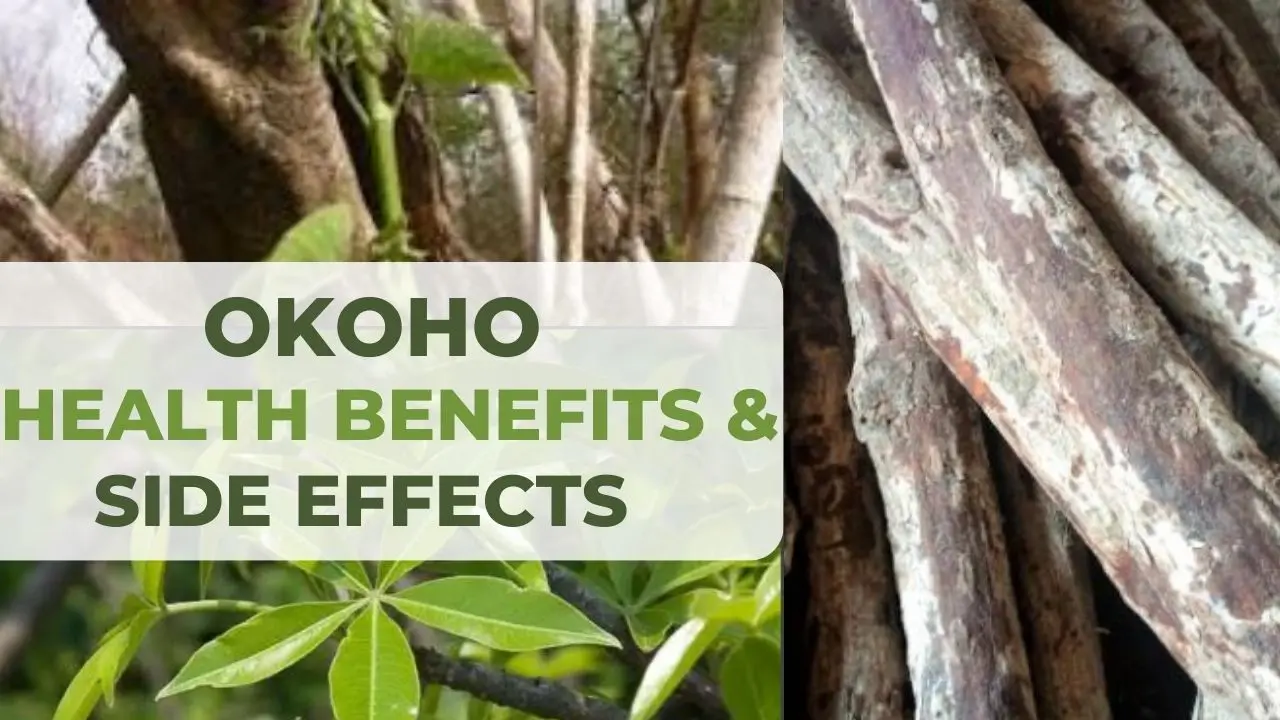
Okoho is a traditional Idoma food and medicine made from the fibre-rich stem of the Cissus populnea plant. This grape family plant, which grows in parts of Africa, has been used for centuries to promote health and well-being.
This plant has many health benefits, such as helping with weight loss, diabetes, blood pressure, cholesterol, immunity, digestion, skin, and hair. However, it also has some side effects that need to be considered before using it.
In this article, we will explore what the Okoho stem is, where it comes from, what it contains, how it can improve your health, what its side effects are, and how it can be used medicinally. So, if you’re ready to know everything about the Okoho Plant, let’s dive in!
What is Okoho?
Okoho Soup is made from the stem of Cissus populnea, which is a woody vine that grows up to three metres tall. The stem is peeled and stripped into thin strands that are soaked in hot water to release a slimy substance. This substance acts as a thickener and a binder for the soup, which is usually prepared with bush meat, dried fish, locust beans, melon seeds, pepper, salt, and seasoning cubes.
The soup is best served with pounded yam, semolina, eba, or yam flour. It is a delicacy that is highly respected and demanded at Idoma events such as weddings, burials, birthdays, and festivals.
History and Origin of Okoho
Okoho originates from the Idoma people of central Nigeria. According to ethnobotanical research, the Idoma settled in parts of Benue State, likely around the 15th-16th century AD, having migrated from northern and northeastern regions.
In their new homeland, the Idoma discovered an abundance of the indigenous Cissus populnea vine, belonging to the grape family. They began using the mucilaginous stem of this plant as a thickening agent for soups, creating the dish known as okoho.
Additionally, the Idoma recognised the medicinal properties of okoho, using it to treat various ailments. Its use quickly spread throughout Idoma culture as both a nutritious food and traditional medicine.
Neighbouring ethnic groups like the Igala, Igbo, Yoruba, and Hausa adopted okoho into their cuisines after learning about it from the Idoma, incorporating it with local seasonings and ingredients. They gave it different names according to their languages. For example, it is called ajara or orogbolo by the Yoruba people, dafara or latutuwa by the Hausa people, okoho by the Igala and Igbo people, etc.
Today, the preparation and consumption of okoho soup remain an important part of Idoma’s identity and are still widely enjoyed for their cultural significance, nutritional benefits, and therapeutic properties. Its use has spread across Nigeria and beyond by diaspora communities who recognise its rich history.
Nutritional Value of Okoho
Okoho is not only a delicious food but also a nutritious one. It contains many nutrients and phytochemicals that are beneficial for health. According to a study, the stem of Cissus populnea contains the following nutrients per 100 g of dry weight:
- Carbohydrates: 66.7 g
- Protein: 5.6 g
- Fat: 1.2 g
- Fiber: 9.8 g
- Ash: 17.7 g
- Moisture: 4.8 g
- Energy: 318 kcal
The stem also contains the following phytochemicals per 100 g of dry weight:
- Tannins: 1.2 g
- Saponins: 0.8 g
- Flavonoids: 0.6 g
- Alkaloids: 0.4 g
- Anthraquinones: 0.2 g
- Ascorbic acid: 0.1 g
In addition, the stem contains carotenoids, triterpenoids, steroids, and phenols that have antioxidant and anti-inflammatory properties.
Health Benefits of Okoho
Okoho Stem has many health benefits that are derived from its nutrients and phytochemicals. Some of the main benefits are:
Okoho Stem for Weight Loss
Okoho can help with weight loss and obesity by reducing appetite, increasing metabolism, and enhancing fat burning. The fibre in okoho can make you feel full and prevent overeating. The saponins in okoho can stimulate the production of bile acids, which can break down fats and cholesterol in the liver and intestines.
The flavonoids in okoho can modulate the activity of enzymes and hormones that regulate glucose and lipid metabolism. The ascorbic acid in okoho can boost the immune system and prevent infections that can cause inflammation and weight gain.
Okoho Stem for Diabetes
Okoho can help with diabetes by improving blood sugar control and insulin sensitivity. The fibre in okoho can slow down the absorption of glucose and prevent spikes in blood sugar levels. The saponins in okoho can increase the secretion of insulin and enhance its action on the cells.
Flavonoids such as quercetin provide antioxidant and anti-inflammatory activity that protects insulin-secreting beta cells in the pancreas from oxidative damage. The ascorbic acid in okoho can prevent glycation, which is a process that causes proteins to bind with sugars and form harmful compounds that can impair the function of insulin and other proteins.
Okoho Stem for Blood Pressure
Okoho can help with blood pressure by relaxing the blood vessels and reducing the resistance to blood flow. The tannins in okoho can act as vasodilators, which can widen the blood vessels and lower blood pressure. The saponins in okoho can inhibit the activity of angiotensin-converting enzyme (ACE), which is a protein that converts angiotensin I to angiotensin II, a hormone that constricts the blood vessels and raises blood pressure.
The flavonoids in okoho can modulate the production of nitric oxide, which is a gas that relaxes the smooth muscle cells in the blood vessel walls and lowers blood pressure. The ascorbic acid in okoho can prevent oxidative stress and inflammation that can damage the endothelium, which is the inner lining of the blood vessels that regulate blood pressure.
Okoho Stem for Cholesterol
Okoho can help with cholesterol by reducing the levels of bad cholesterol (LDL) and increasing the levels of good cholesterol (HDL). The fibre in okoho can bind with bile acids in the intestines and prevent their reabsorption into the bloodstream, which can lower cholesterol levels. The saponins in okoho can inhibit the synthesis of cholesterol in the liver and increase its excretion through faeces, which can lower cholesterol levels.
The flavonoids in okoho can activate the receptors for peroxisome proliferator-activated receptor (PPAR), which is a protein that regulates lipid metabolism and gene expression, which can lower cholesterol levels. The ascorbic acid in okoho can prevent oxidation of LDL, which is a process that makes LDL more harmful and prone to form plaques in the arteries, which can cause atherosclerosis and heart disease.
Okoho Plant for Immunity
Okoho can help with immunity by enhancing the function of immune cells and preventing infections. The carotenoids in okoho can act as precursors for vitamin A, which is a vitamin that supports the growth and differentiation of immune cells such as lymphocytes, macrophages, natural killer cells, etc., which can fight against pathogens and tumours.
The triterpenoids in okoho can stimulate the production of interferons, which are proteins that inhibit viral replication and activate other immune cells. The steroids in okoho can modulate the immune response and prevent excessive inflammation that can damage the tissues. The phenols in okoho can act as antimicrobials, which can kill or inhibit the growth of bacteria, fungi, viruses, and parasites.
Okoho Stem for Digestion
Okoho can help with digestion by improving the function of the gastrointestinal tract and preventing constipation. The fibre in okoho can increase the bulk and softness of the stool and stimulate peristalsis, which is the movement of the intestinal muscles that push the food along the digestive tract.
The saponins in okoho can protect the mucous membrane of the stomach and intestines from ulcers and erosions caused by acid, bacteria, or drugs. The flavonoids in okoho can increase the secretion of digestive enzymes and hormones that regulate digestion and appetite.
Okoho Stem for Skin and Hair
Okoho can help with skin and hair by improving their quality and appearance. The carotenoids in okoho can act as antioxidants, which can protect the skin and hair from oxidative damage caused by UV rays, pollution, or stress. The triterpenoids in okoho can stimulate the production of collagen and elastin, which are proteins that provide structure and elasticity to the skin and hair.
The steroids in okoho can regulate the production of sebum, which is an oily substance that lubricates and moisturises the skin and hair. The phenols in okoho can act as anti-inflammatory agents, which can reduce redness, swelling, itching, and irritation of the skin and scalp.
Side Effects of Okoho
Okoho is generally safe and well tolerated by most people, but it may also have some side effects that need to be considered before using it. Some of the side effects are:
- Allergic reactions: Some people may be allergic to okoho or its components, which can cause symptoms such as rash, hives, itching, swelling, etc. If you experience any of these symptoms after consuming Okoho, seek medical attention immediately.
- Gastrointestinal disturbances: Some people may experience gastrointestinal disorders such as nausea, vomiting, diarrhoea, abdominal pain, gas, bloating, etc., after consuming okoho. This may be due to the high fibre content or the saponins in okoh, which can irritate the digestive system. To prevent or reduce these effects, don’t overeat Okoho and drink plenty of water.
- Hypotension: Some people may experience hypotension or low blood pressure after consuming okoho. This may be due to the vasodilating effects of tannins or the ACE-inhibiting effects of saponins in okoho, which can lower blood pressure too much. To prevent or reduce this effect, monitor your blood pressure regularly and consult your doctor before using okoho if you have a history of hypotension or are taking medications for hypertension.
- Hypoglycemia: Some people may experience hypoglycemia or low blood sugar after consuming okoho. This may be due to the glucose-lowering effects of saponins or flavonoids in okoho, which can lower blood sugar too much. To prevent or reduce this effect, monitor your blood sugar regularly and consult your doctor before using okoho if you have a history of hypogycemia or are taking medications for diabetes.
Okoho Stem Medicinal Uses
For centuries, the Cissus populnea plant, commonly known as okoho, has been used in African traditional medicine to treat a variety of conditions. Modern research has helped validate some of Okoho’s traditional therapeutic uses:
- Wound Healing: Topical application of okoho stem extracts may accelerate wound closure by promoting collagen synthesis, increasing cell proliferation, and reducing inflammation.
- Bone Fracture Healing: Oral or topical okoho preparations may support fracture recovery by stimulating osteoblasts, increasing bone mineral density, and lowering inflammation.
- Pain Relief: Compounds in okoho stem extracts demonstrate analgesic and anti-inflammatory properties by inhibiting prostaglandin production and interacting with opioid receptors.
- Malaria: Extracts of okoho stems have shown in vitro and in vivo antimalarial activity against Plasmodium falciparum, the parasite causing malaria. The extracts may inhibit parasite growth and development.
- Gastric Ulcers: Oral okoho extracts exhibited gastroprotective effects in animal studies by protecting the stomach lining from damage induced by acid, pepsin, ethanol, stress, and other factors.
While human clinical trials are still needed, the emerging research provides a scientific basis for okoho’s traditional medicinal applications.
Frequently Asked Questions
What is Okoho in English?
Okoho is called Cissus Populnea.
How Much Okoho Plant Should I Consume Per Day?
There is no official recommendation on how much okoho plant you should consume per day, but it is generally safe to consume up to 100 g of fresh okoho stem per day.
Can I Use Okoho Plant During Pregnancy or Breastfeeding?
There is not enough scientific evidence on the safety of using the okoho plant during pregnancy or breastfeeding. Therefore, it is best to avoid using it during these periods, use or eat Okoho in moderation, or consult your doctor before using it if you are pregnant or breastfeeding.
Can I Use Okoho Plant With Other Herbs or Supplements?
Okoho may interact with other herbs or supplements that have similar or opposite effects on blood sugar, blood pressure, blood clotting, etc. Therefore, it is important to consult your doctor before using the okoho plant with other herbs or supplements.
Can I Use Okoho With Medications?
Okoho may interact with other drugs or medication, so it’s advisable not to use Okoho if you’re on drugs or medication to avoid allergic reactions.
Conclusion
Okoho is a traditional Idoma food and medicine derived from the Cissus populnea plant stem. It has been used for centuries in parts of Africa for its nutritional and therapeutic properties.
Research shows okoho contains various beneficial nutrients, antioxidants, and other bioactive compounds. When used appropriately, it may provide health benefits like supporting healthy weight, blood sugar, digestion, immunity, skin, and hair. There is also some scientific evidence validating okoho’s traditional uses for wound healing, pain relief, malaria, and more.
However, potential side effects can also occur with okoho, especially when consumed in excess. These may include allergic reactions, gastrointestinal issues, dangerously low blood pressure or blood sugar, and interactions with medications.




